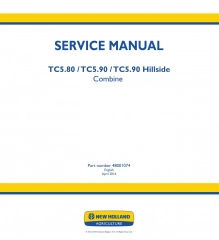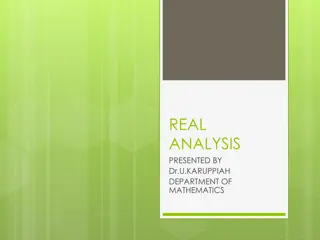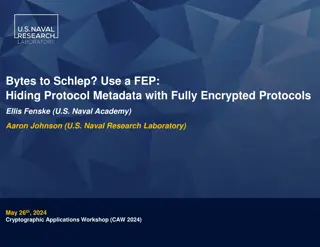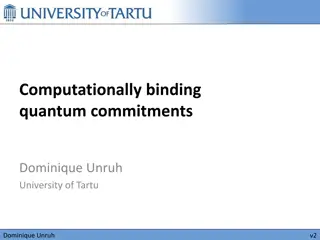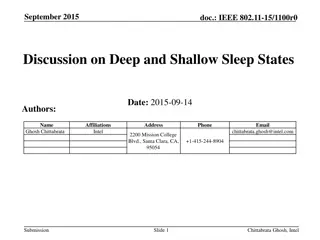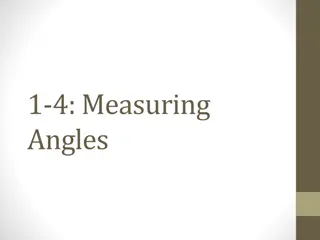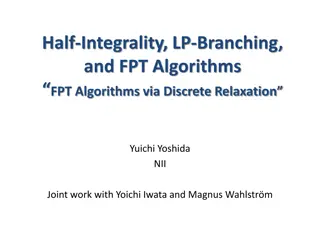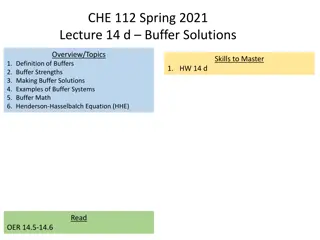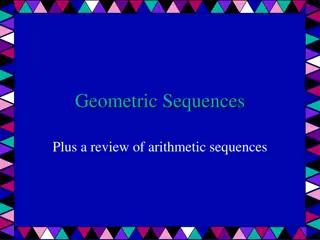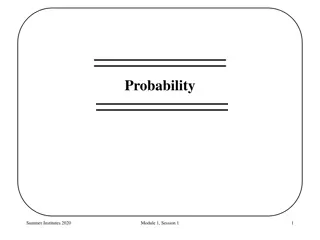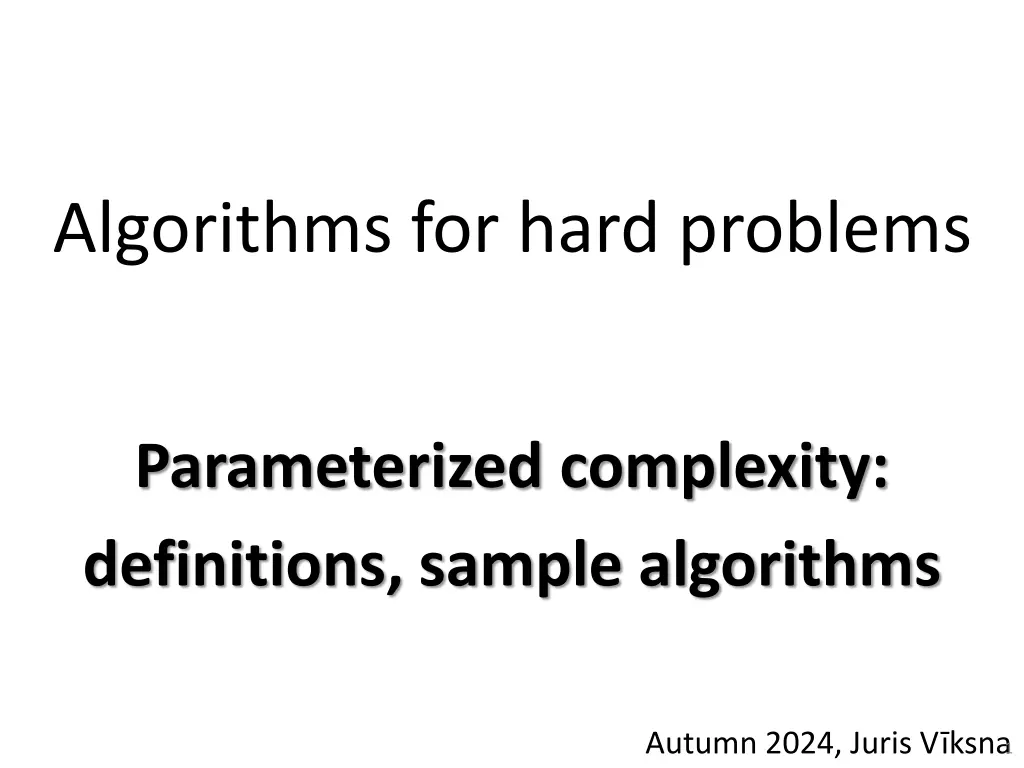
Parameterized Complexity and Sample Algorithms
"Explore parameterized complexity in algorithms for hard problems, featuring definitions, sample algorithms, and the concept of confining combinatorial explosion. Dive into instances such as Vertex Cover, Graph Genus, and Graph Linking Number to understand the approach to solving NP-hard problems efficiently."
Download Presentation

Please find below an Image/Link to download the presentation.
The content on the website is provided AS IS for your information and personal use only. It may not be sold, licensed, or shared on other websites without obtaining consent from the author. If you encounter any issues during the download, it is possible that the publisher has removed the file from their server.
You are allowed to download the files provided on this website for personal or commercial use, subject to the condition that they are used lawfully. All files are the property of their respective owners.
The content on the website is provided AS IS for your information and personal use only. It may not be sold, licensed, or shared on other websites without obtaining consent from the author.
E N D
Presentation Transcript
Algorithms for hard problems Parameterized complexity: definitions, sample algorithms Autumn 2024, Juris V ksna 1
Parameterized complexity Combinatorial "explosion" for NP-hard problems [Adapted from R.Downey and M.Fellows] 2
Parameterized complexity Parameterized complexity attempts to confine combinatorial "explosion" [Adapted from R.Downey and M.Fellows] 3
Parameterized complexity - Definitions Definition (FPT) A parametrized problemL * Parameter Tractable if there is an algorithm that for input (x,y) * * with |x| = k and |y| = n decides whether (x,y) L in time f(k) n , where f is an arbitrary function and is a constant. * is Fixed Definition does not change if f(k) n is replaced by f(k) + n (!) 4
Parameterized complexity - Definitions Mk for every n solves the problem in time f(k) n For each k there is a constant ck, such that f(k) n > n + 1 for n ck - simulates Mk for n ck - looks up value from the table for n ck M'k: M'k solves the problem in time f(k) ck + n a+1 5
Some parameterized problems VERTEX COVER Instance: Parameter: A graph G=(V,E) A positive integer k Is there a subset S V, such that |S|=k and for all {x,y} E either x S or y S? Question: [Adapted from R.Downey and M.Fellows] 6
Some parameterized problems GRAPH GENUS Instance: Parameter: A graph G=(V,E) A positive integer k Question: Does graph G have genus k? [Adapted from R.Downey and M.Fellows] 7
Some parameterized problems GRAPH LINKING NUMBER Instance: Parameter: A graph G=(V,E) A positive integer k Question: Can G be embedded in 3-space such that the maximum size of a collection of topologically linked disjoint cycles is bounded by k? [Adapted from R.Downey and M.Fellows] 8
Some parameterized problems VERTEX COVER: A single algorithm running in time 2k |G| for each k [Downey and Fellows 1992] GRAPH GENUS: A single algorithm which for each fixed k determines whether graph G has genus k in time O(|G|3) [Fellows and Langston 1988] GRAPH LINKING NUMBER: For each k there is an algorithm k, which determines whether graph G has linking number k in time O(|G|3) [Fellows and Langston 1988] 9
Parameterized complexity - Definitions A problem L is uniformly FPT, if there is an algorithm , a constant c and a function f, such that: - the running time of ( x,k )is at most f(k)|x|c - x,k A iff ( x,k ) = 1. A problem L is strongly uniformly FPT, if L is uniformly FPT via some and f, such that f is recursive. A problem L is nonuniformly FPT if there is a constant c, a function f and a collection of algorithms { k}k N, such that for each k: - the running time of k( x,k )is at most f(k)|x|c - x,k A iff k( x,k ) = 1. 10
"klam" values Tower of 2's of height described by tower of 2's of height described by tower of 2's... (impractical even for k = 1 :) Algorithms for VERTEX COVER: O(f(k) n3) [Fellows, Langston 1986] O(f(k) n2) [Johnson, 1987] 22500k FPT if solvable in time f(k)+nc klam value - the largest k for which f(k) is less that some universal "speed limit" U (e.g. U= 1020) [Adapted from R.Downey and M.Fellows] 11
"klam" values Tower of 2's of height described by tower of 2's of height described by tower of 2's... (impractical even for k = 1 :) Algorithms for VERTEX COVER: O(f(k) n3) [Fellows, Langston 1986] O(f(k) n2) [Johnson, 1987] 22500k FPT if solvable in time f(k)+nc klam value - the largest k for which f(k) is less that some universal "speed limit" U (e.g. U= 1020) [Adapted from R.Downey and M.Fellows] 12
Parameterized complexity Parametrized tractability (methods for constructing FPT algorithms) Parametrized intractability (how to "prove" that there are no FPT algorithm for a given problem) 13
Bounded search tree methods First, construct a search space (tree), such that the size search space depends only from parameter k Then run some relatively efficient algorithm (say DFS) on each branch of the tree For fixed k search space is of constant size, thus we obtain a FPT algorithm 14
Bounded search tree methods - Vertex cover , G {u1,v1} {u1}, G-{u1} {v1}, G-{v1} k+1 {u2,v2} {v1,u2}, G-{v1,u2} {v1,v2}, G-{v1,v2} By considering only graphs with vertices of degree 3 or higher, it is possible to shrink search space from 2k to (51/4)k [Balasubramanian et al 1997] Theorem [Downey and Fellows 1992] VERTEX COVER is solvable in time O(2k |V(G)|). 15
Kernel methods The main idea of the reduction to problem kernel is to reduce a problem instance I to an equivalent instance I', where the size of I' is bounded by some function of the parameter k. The instance I' is then exhaustively analyzed, and a solution for I' lifted to a solution to I. Usually this will give and additive rather that multiplicative f(k) exponential factor 16
Kernel methods - Vertex cover Theorem [Buss 1989] VERTEX COVER is solvable in time O(k2k + k |V(G)|). Observation Any vertex of degree greater than k must belong to every k-element vertex cover. Step 1 Locate all vertices in G of degree greater than k; let p equal the number of such vertices. If p > k, there is no k-vertex cover. Otherwise let k' = k p. Step 2 Discard all vertices found in step 1 and the edges incident to them. If the resulting graph G' has more than k'(k+1) vertices, reject. 17
Kernel methods - Vertex cover Observation Any vertex of degree greater than k must belong to every k-element vertex cover. Graph with k' vertex cover and vertex degree bounded by k has up to k'(k+1) vertices Step 1 Locate all vertices in G of degree greater than k; let p equal the number of such vertices. If p > k, there is no k-vertex cover. Otherwise let k' = k p. Step 2 Discard all vertices found in step 1 and the edges incident to them. If the resulting graph G' has more than k'(k+1) vertices, reject. Doable in O(k2k) time Step 3 If G' has no k'-vertex cover, reject. Otherwise, any k'-vertex cover of G' plus the p vertices from step 1 constitutes a k-vertex cover for G. 18
Kernel methods - Vertex cover Search tree method Kernel method O(2k |V(G)|) O((51/4)k |V(G)|) O(k2k + k |V(G)|) If we use reduction to problem kernel first, and then apply search tree method to problem kernel, we improve additive bounds to: O(kn + 2kk2) [Balasubramanian et al 1992] O(kn + ((51/4)kk2) [Balasubramanian et al 1992] 19

